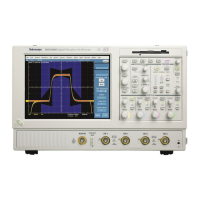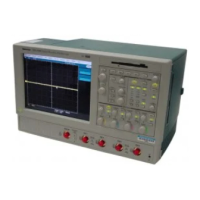388
Runt Trigger Criteria
Select Occurs from the Runt drop-down list to trigger on any runt.
Select Wider from the Runt drop-down list to trigger on a runt pulse of a minimum width. Click
Width and use the multipurpose knob to set the minimum pulse width.
Select Logic from the Runt drop-down list to trigger on a logic-qualified runt pulse. When the
instrument detects that a runt has occurred, it checks the logical state of two other available
channels and triggers only if their conditions are met. Each channel can have a value of high (H),
low (L), or "don't care" (X). A value is considered high if the channel input voltage is greater than
the specified threshold voltage; a value is considered low if the channel input voltage is less than
the specified threshold voltage. Use the "don't care" selection for any channels that will not be
used as part of the pattern.
Note
The Logic qualification option is available only on 4-channel models.
Scan Controls
These controls are available only for the Custom video format. Interlaced and Progressive are
available for the Scan Type.
Custom scan rates enable you to trigger on nonbroadcast video signals that have unique scan rates.
Select the scan rate range that includes your signal: 15-20 kHz, 20-25 kHz, 25-35 kHz, 35-50 kHz,
or 50-65 kHz.
Scallop Loss
Scallop loss is the difference between the actual magnitude and the computed magnitude of a
signal that is halfway between two frequency bins in the spectral output data. Scallop loss is only
noticeable when the spectral analyzer is not using zero-fill such as when it is set to full span. If
zero-fill is in use, then the frequency domain interpolation occurs and there is essentially no
scallop loss. Zero-fill cannot be directly controlled; it is affected by changing settings of resolution
bandwidth or gate width.
Note
For most settings, descriptions of amplitude accuracy due to scallop loss (as discussed in other
publications) do not apply to the TDS5000B Series Oscilloscope when used as a spectral analyzer
because of zero-fill. Full span is the most likely setting where scallop loss might occur.
Set to 50%
Click this button to automatically have the instrument search for and set the trigger level to a value
halfway between the peaks of the trigger source signal. This has the same effect as pushing the
front-panel LEVEL knob.
Setup and Hold Time
Setup time is the amount of time that data has to be stable after crossing the threshold level prior
to a clock edge. Hold time is the amount of time that data has to be stable before crossing the
threshold level after a clock edge.

